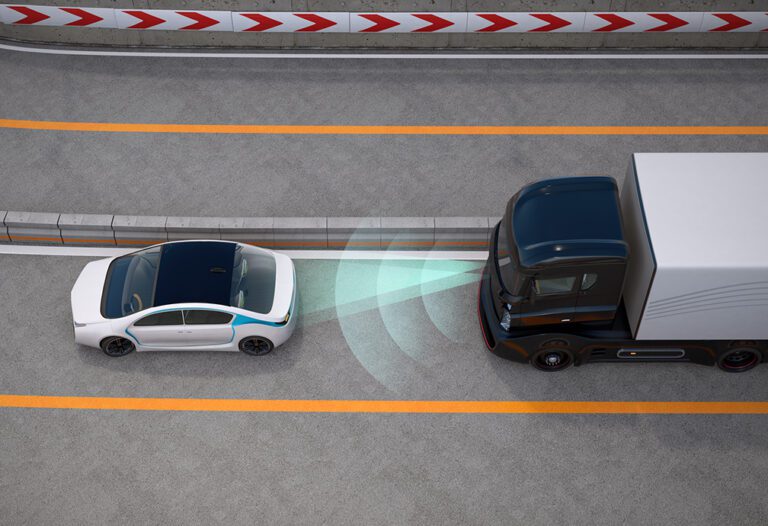Automatic emergency braking (AEB) could arguably be one of the most talked about issues in the trucking industry these days.
The comment period for a proposal to require new heavy vehicles weighing more than 10,000 pounds to be equipped with AEB systems has concluded on the Federal Register, with much debate on both sides of the issue. Now, it’s up to the National Highway Traffic Safety Administration (NHTSA) and Federal Motor Carrier Safety Administration (FMCSA) to make the final ruling.
Both agencies contend that AEB systems “will mitigate the frequency and severity of rear-end crashes.”
“Advanced driver assistance systems like AEB have the power to save lives,” said Ann Carlson, chief counsel for the NHTSA. “(This) is an important step forward in improving safety on our nation’s roadways by reducing, and ultimately eliminating, preventable tragedies that harm Americans.”
The Truckload Carriers Association, along with the Truck Safety Coalition, Road Safe America, and The Trucking Alliance and Advocates for Highway and Auto Safety, published a fact sheet that outlines the AEB issue and the benefits the technology could bring industrywide. The fact sheet also questioned whether AEB systems are effective.
According to the fact sheet, that AEB systems can:
- Prevent and mitigate truck crashes in which the truck rear-ends a passenger vehicle; these types of truck crashes have increased 50 percent since 2009.
- Address other crashes in which a truck is the striking vehicle, such as fatal work zone collisions; large trucks are largely overrepresented in these types of crashes, with at least one large truck involved in 30% of fatal work zone crashes in 2017.
One major trucking company reported it has experienced a 69% decrease in rear-end crashes since it began equipping all new tractors with AEB in 2012
Another large motor carrier saw a 71% reduction in rear-end collisions in trucks equipped with AEB in addition to electronic stability control and lane-departure warnings, compared to trucks without these safety systems.
The American Trucking Associations is also in favor of the use of AEB systems.
“ATA has long supported the use of AEB on all new vehicles,” said Dan Horvath, vice president of safety policy for ATA. “With NHTSA’s recent regulation requiring AEB on all new passenger vehicles, this proposal for heavy duty trucks is timely and appropriate.
“The trucking industry supports the use of proven safety technology like automatic emergency braking,” Horvath continued. “We look forward to reviewing this proposal from NHTSA and FMCSA and working with them as it is implemented.”
In 2015, the ATA urged car and truck manufacturers to make AEB systems standard equipment on new vehicles. In 2021, the association supported legislation that would have mandated AEB technology on new Class 7 and 8 trucks.
Jeremy Stickling, chief administrative officer for Nussbaum Transport Services, said his company is a strong believer in AEB systems.
“We were on the front end of this technology and had the early versions of AEB in our trucks, if I recall properly, since 2010,” Stickling said.
While some opponents of mandatory AEB systems cite cost as a concern, Stickling pointed to the high cost of rear-end collisions.
“When a rear-end happens, there is often bodily injury involved, and you are considered an at-fault party,” he said. “Since embracing collision mitigation and AEB, our rear-end crashes have essentially vanished. On the very rare occasions they do happen, we believe the impact is significantly less severe than it would be otherwise.”
Stickling added that Nussbaum has all but eliminated the “high-liability crash type from our loss runs. This is great for public safety. And it is good business as well.”
Even with the safety benefits of AEB, not everyone in the industry supports the mandate.
Jay Grimes, director of federal affairs for the Owner-Operator Independent Drivers Association, said agencies must resolve any performance issues with the systems before attempting to move forward.
“We are always going to have concerns about regulatory mandates for technology or any other rulemaking that hasn’t been proven to benefit highway safety,” Grimes told OOIDA’s online news site, Land Line, adding that the association has heard concerns from drivers about false activation of these systems. These incidents, he said, take control out of a driver’s hands, compounding the issue of whether AEB systems will work properly in all weather and road conditions.
“This proposal is being announced and released at the same time some of the studies for AEB on commercial vehicles are ongoing and haven’t been completed,” he said.
An AEB system uses multiple sensor technologies that work together to detect a vehicle in a crash imminent situation. The system automatically applies the brakes if the driver has not already done so, or, if needed, applies more braking force to supplement the driver’s braking. The proposed standard would require the technology to work at speeds ranging between low-speed (6 mph) and high-speed (roughly 50 mph) situations
“Establishing AEB standards is a key component of the Department’s National Roadway Safety Strategy,” said FMCSA Administrator Robin Hutcheson. “This technology can enhance the effectiveness of commercial motor vehicle crash reduction strategies and reduce roadway fatalities.”
According to NHTSA statistics, there are about 60,000 rear-end crashes a year in which a heavy vehicle is the striking vehicle. Once implemented, NHTSA estimates the proposed rule will prevent 19,118 crashes, save 155 lives and prevent 8,814 injuries annually. NHTSA and FMCSA incorporated feedback from the safety advocacy community, industry representatives, and other interested parties to address this critical safety need on America’s roads.
In January 2022, the U.S. Department of Transportation (DOT) released the National Roadway Safety Strategy (NRSS), a road map to address the national crisis of motor vehicle fatalities and serious injuries.
The DOT also launched the “Call to Action” phase of the NRSS and released a one-year progress report with accompanying data that highlight the extent and magnitude of the nation’s highway safety problem and ways to eventually bring the number of deaths on our roadways to zero.
Federal officials say new technology, such as AEBs, are vital to the future of roadway safety.
Back at Nussbaum, Stickling said that while AEB systems are not perfect, they are beneficial to both truck drivers and everyone else on the road.
“It would be foolish to pretend the systems are perfect,” he said. “They certainly have quirks. Sometimes they beep or do ‘haptic braking’ (brake stab) when they shouldn’t. In very rare instances, they have stopped the truck without a good reason. And we don’t want to be insensitive to this — it can be annoying at times.”
However, Stickling said, the imperfections don’t “add much risk at all,” noting that the crash prevention benefits of AEBs are “extremely high.”
“And the technology keeps getting better,” he said. “I think we are on the fourth or fifth generation of this by now. Each one gets better, and that trend will continue.”
This article originally appeared in the September/October 2023 edition of Truckload Authority, the official publication of the Truckload Carriers Association.
Linda Garner-Bunch has been with The Trucker since 2020, picking up the reins as managing editor in 2022. Linda has nearly 40 years of experience in the publishing industry, covering topics from the trucking and automotive industry to employment, real estate, home decor, crafts, cooking, weddings, high school sports — you name it, she’s written about it. She is also an experienced photographer, designer and copy editor who has a heartfelt love for the trucking industry, from the driver’s seat to the C-suite.














